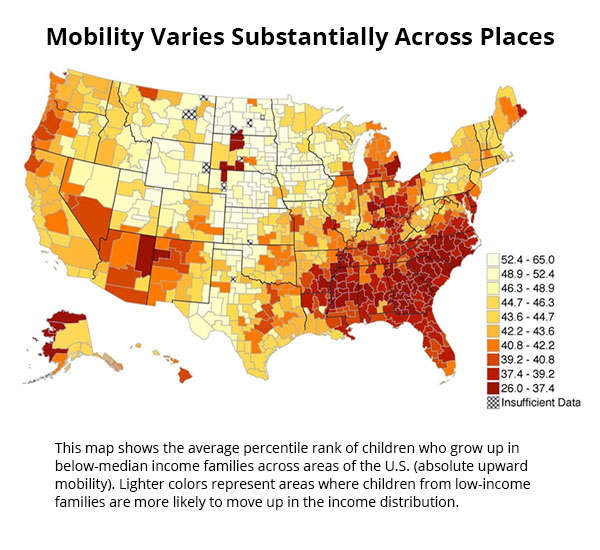Yesterday, I participated in a Center for American Progress forum where a new study on unions and social mobility was released. The study, by my Harvard colleague Richard Freeman and collaborators, showed a significant correlation across American metropolitan areas between the extent of union membership and social mobility. Freeman, who based his research on data in the famous studies of Raj Chetty and his collaborators, also showed that the children of union members earn higher wages and are healthier than other children.
This is important work. From Ted Cruz to Bernie Sanders, there is agreement across the political spectrum that equality of opportunity is an American ideal — that Thomas Jefferson was right in saying that America should be an aristocracy of talent. Yet equality of opportunity in the U.S., no matter how measured, lags behind other countries and certainly has not progressed over the last several decades.
Chetty’s celebrated “equal opportunity map,” reproduced below, shows that there are no grounds for fatalism. Different parts of the U.S. deliver very different levels of social mobility, while all in the same global economy, with the same technology, and the same increasing proclivity of able men and women to marry each other. There is nothing immutable about the existing inadequate level of equal opportunity.
The map demonstrates that equality of opportunity is particularly bad in the old confederacy and particularly good in some of the old bastions of abolitionism. It is not therefore surprising that unions, which were concentrated in the North, turn out to be correlated with equal opportunity. More impressive is the research result that looking across families, fathers who are union members have children who earn at least 15 percent more than those who are not in union families, and that this stands up even with various control variables added. The implication is that supporting unions not only helps workers who are members themselves but also helps their children and communities as well.
Few people believe that private unions in the United States had excessive power in the 1970s. Yet the share of private sector workers in unions has fallen from over 24 percent in 1973 to under 7 percent today. Unions are surely too weak today. Their weakness most clearly shows up in workers who have difficulty maintaining a middle class lifestyle. In a more profound way, the weakness of unions leaves a broad swath of the middle class largely unrepresented in the political process, paving the way for the kind of disillusionment that has driven the Trump candidacy. After all, no society is going to remain stable and confident in its central institutions if parents do not believe their kids can lead better lives than they did.
In 2009, at the Brookings Institution, I spoke about the important role of unions in generating broadly shared growth. I said, “If we want to propel this economy forward and we want to have a sound expansion, it has to be an expansion whose benefits are more broadly shared. And that goes to the question of tax policy and progressivity, it goes to the question of education over the longer term, and it goes to the question of having a healthy and well-functioning trade union movement.”
Broadly shared prosperity is even more elusive today, so what is needed going forward? I would suggest three important steps.
First, we need serious enforcement of laws to stop employers from punishing workers seeking to engage in collective action. Enforcement has historically lagged badly as it typically takes at least four and often as many as seven years for cases to be decided. And even if employers are eventually found guilty of violating the rules, the penalty is generally under $10,000 per harmed worker. Anti-union employers can violate the law with near-impunity worrying only about slaps on the wrist years in the future. As Morris Kleiner and David Weill found: “expected costs [for being found guilty of violating labor laws] represent a fraction of the benefits to employers … from thwarting organizing drives. It is therefore not surprising that there has been a sevenfold increase in the percentage of violations of the act”.1
Second, the union movement needs to expand on its efforts to build models of collective action that are not rooted in traditional command and control corporation. This may include increased emphasis on profit sharing, on labor management dialogue, on industry wide bargaining, and many other ideas as well. Organized Labor needs to adapt to the pervasiveness of white collar, pink collar, and no collar work in addition to traditional blue collar work.
Third, there is a compelling case even if it does not appear politically realistic right now for labor law reform to give more scope to those seeking to organize workers. There are detailed agendas of possible reform. What is important now is that a consensus form around the idea of reducing burdens on union organizers.
Thanks to the work of Freeman and his collaborators, we now know that stronger unions are not just good for their members, they are good for our country and our descendants. Strengthening collective worker voice has to be an important component of any realistic American inclusive growth agenda.
- Kleiner and Weill, EVALUATING THE EFFECTIVENESS OF NATIONAL LABOR RELATIONS ACT REMEDIES: ANALYSIS AND COMPARISON WITH OTHER WORKPLACE PENALTY POLICIES, NBER Working Paper 16626 ↩


2 comments